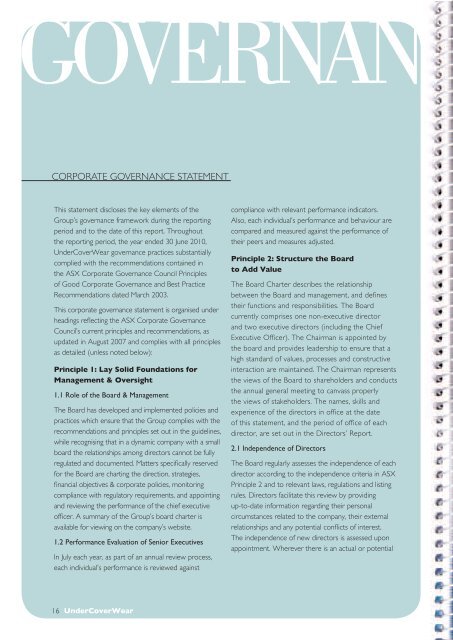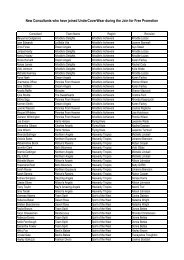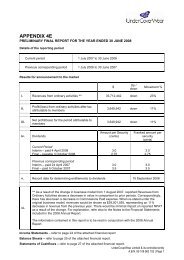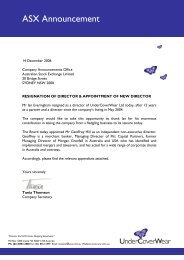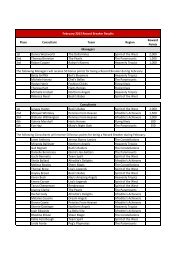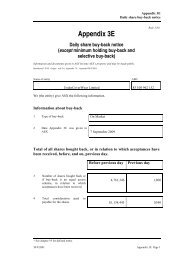Annual Report 2010 - UnderCoverWear
Annual Report 2010 - UnderCoverWear
Annual Report 2010 - UnderCoverWear
Create successful ePaper yourself
Turn your PDF publications into a flip-book with our unique Google optimized e-Paper software.
GOVERNAN CE<br />
CORPORATE GOVERNANCE STATEMENT<br />
This statement discloses the key elements of the<br />
Group’s governance framework during the reporting<br />
period and to the date of this report. Throughout<br />
the reporting period, the year ended 30 June <strong>2010</strong>,<br />
<strong>UnderCoverWear</strong> governance practices substantially<br />
complied with the recommendations contained in<br />
the ASX Corporate Governance Council Principles<br />
of Good Corporate Governance and Best Practice<br />
Recommendations dated March 2003.<br />
This corporate governance statement is organised under<br />
headings reflecting the ASX Corporate Governance<br />
Council’s current principles and recommendations, as<br />
updated in August 2007 and complies with all principles<br />
as detailed (unless noted below):<br />
Principle 1: Lay Solid Foundations for<br />
Management & Oversight<br />
1.1 Role of the Board & Management<br />
The Board has developed and implemented policies and<br />
practices which ensure that the Group complies with the<br />
recommendations and principles set out in the guidelines,<br />
while recognising that in a dynamic company with a small<br />
board the relationships among directors cannot be fully<br />
regulated and documented. Matters specifically reserved<br />
for the Board are charting the direction, strategies,<br />
financial objectives & corporate policies, monitoring<br />
compliance with regulatory requirements, and appointing<br />
and reviewing the performance of the chief executive<br />
officer. A summary of the Group’s board charter is<br />
available for viewing on the company’s website.<br />
1.2 Performance Evaluation of Senior Executives<br />
In July each year, as part of an annual review process,<br />
each individual’s performance is reviewed against<br />
compliance with relevant performance indicators.<br />
Also, each individual’s performance and behaviour are<br />
compared and measured against the performance of<br />
their peers and measures adjusted.<br />
Principle 2: Structure the Board<br />
to Add Value<br />
The Board Charter describes the relationship<br />
between the Board and management, and defines<br />
their functions and responsibilities. The Board<br />
currently comprises one non-executive director<br />
and two executive directors (including the Chief<br />
Executive Officer). The Chairman is appointed by<br />
the board and provides leadership to ensure that a<br />
high standard of values, processes and constructive<br />
interaction are maintained. The Chairman represents<br />
the views of the Board to shareholders and conducts<br />
the annual general meeting to canvass properly<br />
the views of stakeholders. The names, skills and<br />
experience of the directors in office at the date<br />
of this statement, and the period of office of each<br />
director, are set out in the Directors’ <strong>Report</strong>.<br />
2.1 Independence of Directors<br />
The Board regularly assesses the independence of each<br />
director according to the independence criteria in ASX<br />
Principle 2 and to relevant laws, regulations and listing<br />
rules. Directors facilitate this review by providing<br />
up-to-date information regarding their personal<br />
circumstances related to the company, their external<br />
relationships and any potential conflicts of interest.<br />
The independence of new directors is assessed upon<br />
appointment. Wherever there is an actual or potential<br />
conflict of interest or material personal interest, the<br />
Board’s policies and procedures ensure that:<br />
n the interest is fully disclosed and the disclosure is<br />
recorded in the register of director’s interest and in<br />
the Board minutes;<br />
n the relevant director is excluded from all<br />
considerations of the matter by the Board;<br />
n the relevant director does not receive any segment<br />
of the Board papers or other documents in which<br />
there is any reference to the matter.<br />
The Chairman, Mr Stuart Richardson, is a nonexecutive<br />
independent director in accordance with the<br />
independence criteria given that he complies will all<br />
criteria set down for assessment of independence.<br />
Mr John Everett, an executive director, is a substantial<br />
shareholder of the company and is considered not to<br />
be independent.<br />
Mr Richard Lowry, is a non-executive independent<br />
director in accordance with the independence criteria<br />
given that he complies will all criteria set down for<br />
assessment of independence.<br />
Mrs Elaine Vincent, former Chief Executive Officer, was<br />
considered not to be independent.<br />
Due to the small size of the Board, its composition<br />
does not permit the majority of the members to be<br />
independent as recommended by the principle.<br />
2.2 The Chairman should be independent<br />
The Chairman of the Company is an independent nonexecutive<br />
director and has extensive experience serving<br />
as chairman for boards of public and private companies.<br />
2.3 The role of Chairman and the Chief Executive<br />
The role of Chairman and Chief Executive Officer are<br />
exercised by separate individuals.<br />
2.4 Nomination Committee<br />
No formal Nomination Committee exists given that the<br />
size of the Board allows the entire Board to participate<br />
directly in these functions. The procedures of the<br />
Board in relation to matters addressed by a nomination<br />
committee are in compliance with the Principles. Such<br />
responsibilities include reviewing Board membership,<br />
which includes an assessment of the necessary and<br />
desirable competencies of Board members, Board<br />
succession plans and an evaluation of the Board’s<br />
performance and consideration of appointments and<br />
approvals. When a Board vacancy occurs, the existing<br />
Board will identify the particular skills, experience<br />
and expertise required that will best complement its<br />
effectiveness and then undertake a process to identify<br />
candidates who can meet those criteria.<br />
2.5 Board Evaluation<br />
The Board undertakes an annual self-assessment of<br />
its performance, in line with recommendations of<br />
the guidelines prior to the <strong>Annual</strong> General Meeting<br />
each year. Reviews are initially conducted by way<br />
of questionnaire, with the opportunity for followup<br />
discussions if any director thought it would be<br />
beneficial to do so. The Chairman also conducts an<br />
annual assessment of the performance of individual<br />
directors, where necessary, and meets privately<br />
with each director to discuss this assessment. The<br />
Chairman’s performance is reviewed by the Board.<br />
16 <strong>UnderCoverWear</strong><br />
17


